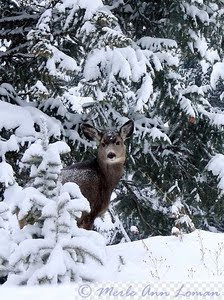
Mule deer doe and fawn (Photo by Merle Ann Loman)
Mule Deer - Odocoileus hemionus
Mule deer in western Montana are an interesting lot. They differ from Montana's other native deer, the white-tailed deer, in their behavior and looks.
They are much more curious and will turn to look at you. Then if alarmed, tuck in their tail and bound off, basically leaping with all four feet together. This is called stotting. They can cover a lot of ground very quickly that way. They range more widely than white-tailed deer, especially in elevational movement, roaming higher into the mountains.
Their coats are grayish in the winter and brown in the summer. They have white rumps, chin and throat, and their tails are short with a black tip. The ears; they are called mule deer for this reason. The ears are very large and prominent, resembling the ears of a mule. On the lower outside of the hind leg, there is a slit-like scent gland up to seven inches long.

Button buck (Photo by Merle Ann Loman)
Their antlers are unique; they fork, and then fork again with the short brow tines tipping forward if they are present at all. The antlers fall off in the winter and begin growing again in the spring. See the photo on the right and the slideshow for more photos of a "button buck" in the early stage of antler development.
Standing from 3 to 3.5 feet tall, mule deer are large deer. Mature bucks weigh about 250-275 pounds, some trophy bucks weigh even more. Mature does weigh from 160 to 180 pounds. They breed in late November and the fawns are born in late June. As with white-tailed deer, the fawns have white spots but their base coat is a dark chocolate brown. The fawns stay with their mother through the summer and are weaned in the fall before rut (breeding season) begins again.
Mule deer does, fawns, and young bucks are frequently seen as they move about the mountains and forage together in groups.

Wintertime (Photo by Merle Ann Loman)
Mature mule deer bucks are another story. During the rut, they will stay with a group of females tending and breeding them, but most of the year they travel alone or in small groups and are very elusive.
During hunting season, mule deer bucks quickly respond to the pressure of hunters in their area and move deep into timber, heavy brush and steep canyons. The big ones get big with good nutrition and because they are smart and crafty. Sometimes they even crawl to evade the aspiring trophy hunter or predator. They will come back out of the thickets again in late November when the does come into estrus, but that doesn't leave much time for the hunter to bag one.
It might take years of research and scouting, but finding that monster mule deer buck is a thrill of a lifetime - even if a photo is what you are after.
Montana Fish, Wildlife and Parks – Hunting guide
Mule Deer Foundation – Western Montana Chapter Spotlight
Kings Outdoor World – All About Antlers
Merle’s SmugMug photo site – see the mule deer photos in their original format
No comments:
Post a Comment